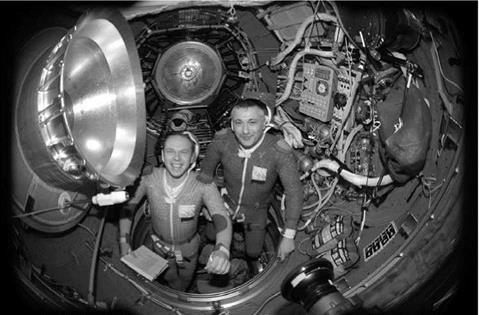EXPEDITION-15
Following the busy hand-over period the Expedition-15 crew began their occupation of ISS with a few days of light workload. While Yurchikhin and Kotov oriented themselves on the station, Williams used her three months of experience to assist them. The new crew participated in drills to maintain medical and emergency skills. Before his launch Yurchikhin had discussed the advantages of having Williams serve with both the Expedition-14 and Expedition-15 crews:
“[U]p to now, almost all the increments were launched together and landed
together. At the initial International Space Station development stage, [Expedi-
tion crews] always rotated by Shuttle flights, then it moved to Soyuz flights. Now that the Shuttle flights [have] resumed we do combined crew rotation… The main problem all the increments are facing is the short time allocated for crew hand-over. And to have somebody on board (Suni will have already spent three months on board) that will have several EVAs as well experience working with robotic operations—and experience working on the unit, USOS [United States Operating Segment]. The main problems were, when the previous crew members would close the hatch and would undock and then we realized, ‘Oh, I forgot to ask this.’ We’re not going to have this problem because we’re going to have Suni with us.’’
Contrast this comment with that made by Michael Lopez-Alegria on p. 259.
In Korolev, Russian flight controllers test-fired the two manoeuvring engines on Zvezda on April 25, raising the station’s orbit in advance of the Progress M-60 and STS-117 launches. An earlier attempt to make this burn had been prevented when an ATV antenna had prevented the engine covers from opening. That antenna had been moved during an EVA. It was the first time the engines in question had been fired since 2000, when they had been used to help deliver Zvezda into orbit. A second burn took place on April 28, and raised the station’s orbit.
|
Figure 86. Expedition-15: Oleg Kotov and Fyodor Yurchikhin pose in their underwear in Zarya’s docking node. They are floating in the hatch leading to Soyuz TMA-10, which is docked at Zarya’s nadir. |
Williams performed a series of flights with the SPHERES satellites. Yurchikhin and Kotov carried out maintenance work, replacing the water separation unit in the air-conditioning system of the Russian segment. The following week was spent undertaking routine maintenance, in preparation for the arrival of Progress M-60. The crew removed the docking system from Progress M-59, for return to Earth on STS-117, while maintaining their experiment programme. Williams completed a session with the Elastic Memory Composite Hinge experiment, designed to study a new hinge composite in space. She also used a hand-held device intended to identify biological and chemical substances on the station, as part of the crew’s health and safety measures. Kotov collected air samples in the Russian modules using the Real-Time Harmful Contaminant Gas Analyser. He also completed maintenance on one of Zarya’s battery temperature sensors. The crew also worked together to perform maintenance in Destiny.
On May 8, they tested communications between ISS and Progress M-59. The following day was one of light duties in recognition of Russia’s Victory Day, that nation’s celebration of the end of the Great War for Independence, World War II. In Houston, flight controllers tested the failed CMG-3 mounted in the Z-1 Truss. By tilting the CMG in different directions they were able to measure the friction involved. At no time was the CMG, which was due to be replaced during the flight of STS-118, spun up to full speed.











